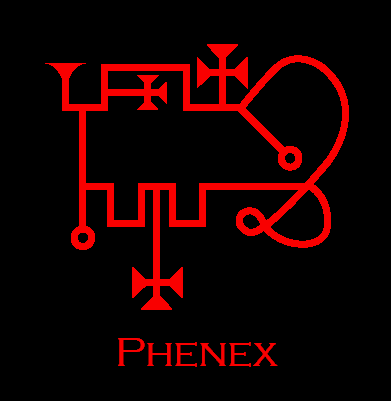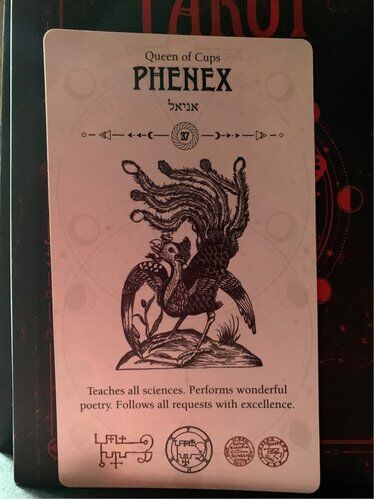Blog, Demons, Working With Demons
Phenex: The 37th Spirit Of Ars Goetia
Overview of Phenex
Phenex is the 37th spirit listed in the Ars Goetia, a 17th-century grimoire detailing 72 demons allegedly summoned by King Solomon. He holds the rank of Great Marquis of Hell, commanding 20 legions of demons. Unlike more overtly malevolent demons, Phenex is characterized by a blend of beauty, intellect, and a poignant longing for redemption. His name and form draw clear inspiration from the mythical phoenix—a bird tied to fire, rebirth, and eternity—though his demonic nature adds layers of complexity.
Powers and Abilities
Phenex is a demon of knowledge and art, offering:
- Mastery of Sciences: He teaches “all wonderful sciences,” from astronomy to alchemy, making him a scholar’s ally.
- Poetic Excellence: Described as an “excellent poet,” he can inspire or recite verses of profound beauty.
- Obedience: Unlike some truculent demons, Phenex is notably compliant, fulfilling the conjurer’s commands willingly.
- Revelation: He speaks “marvelously” of hidden things, potentially unveiling secrets of the past, present, or future.
Some modern occult interpretations (not in the original texts) expand his abilities, linking him to fire manipulation or transformation, tying into his phoenix imagery. However, the Ars Goetia focuses on his intellectual and artistic gifts, not destructive might.
Personality and Motivation
Phenex stands out for his wistful ambition: he hopes to return to Heaven after 1,200 years, reclaiming his place among the seventh order of Thrones (a rank of angels tied to divine will). The text notes this hope is “deceived”—a tragic note suggesting his fall is permanent, despite his yearning. This penitence sets him apart from demons reveling in their rebellion, like Paimon or Belial.
His demeanor blends melancholy with grace. As a fallen Throne, he carries a vestige of celestial dignity, tempered by his infernal station. His obedience and creativity hint at a spirit not wholly consumed by malice, perhaps reflecting his former angelic nature.
Historical Context and Origins
Phenex’s inclusion in the Ars Goetia stems from medieval demonology, a fusion of Jewish, Christian, and pre-Christian traditions. His phoenix form likely borrows from Greco-Egyptian mythology, where the bird symbolized cyclical renewal, but his childlike voice and demonic role are unique embellishments. The Pseudomonarchia Daemonum by Johann Weyer (1577), a precursor to the Lesser Key, lists him similarly, reinforcing his consistency across texts.
His name’s etymology ties directly to “phoenix,” though variant spellings (Pheynix, Phoeniex, etc.) reflect scribal quirks or linguistic drift. Unlike Paimon, whose name’s origins are murkier, Phenex’s link to the phoenix is overt, suggesting a deliberate symbolic choice—perhaps to evoke rebirth thwarted by damnation.
Cultural Depictions
Phenex’s presence in modern culture is subtler than Paimon’s (e.g., Hereditary). He appears in:
- Occult Literature: Beyond the Ars Goetia, he’s noted in works like the Dictionnaire Infernal (1863), which echoes his poetic and scientific prowess.
- Pop Culture: In the anime/light novel High School DxD, the Phenex family wields fire and immortality, a nod to his phoenix roots, though reimagined as a clan rather than a single entity.
- Gaming: In the Shin Megami Tensei series, Phenex is a fire-aligned demon, emphasizing his elemental aspect over his intellectual one.
These adaptations often amplify his fiery traits, sidelining his artistry or redemption arc, contrasting with the Ars Goetia’s focus.
Appearance and Presentation
Phenex appears as a phoenix, a radiant bird wreathed in flames, singing “sweet notes with the voice of a child.” This description, from the Lesser Key of Solomon, paints him as both enchanting and deceptive. His melodies are so captivating that the summoner and any companions must resist listening, quickly commanding him to take human form—a shift he complies with after a brief delay. In human shape, he speaks clearly, shedding the siren-like allure of his avian voice.
This duality—beauty masking danger—echoes the phoenix myth but twists it. Where the phoenix symbolizes renewal, Phenex’s song tempts the unwary, hinting at a seductive power that could ensnare the careless.
Working with Phenex: A Ritual
Here’s a simple, symbolic ritual inspired by Phenex’s nature
Purpose: To seek inspiration, knowledge, or renewal.
Materials:
- A red or orange candle (for fire and the phoenix).
- Paper with Phenex’s sigil (a traditional design from the Ars Goetia).
- Rose petals or cinnamon (for creativity and warmth).
- A quill and ink (for poetry or insight).
Steps:
- Light the candle at dawn (symbolizing rebirth).
- Place the sigil beneath it, surrounded by rose petals or a sprinkle of cinnamon.
- Chant: “Phenex, singer of sweet notes, Marquis of flame, I call your wisdom. Unveil the hidden, inspire my soul.”
- Write a question or intent (e.g., “What path should I take?”).
- Meditate, listening inwardly—not for a literal song, but a spark of intuition.
- Thank him: “Phenex, I honor your light. Depart in peace.” Extinguish the candle.
- Burn or keep the paper, trusting insights to emerge over days.
This ritual avoids the complexity of full Goetic summoning, focusing on Phenex’s gentler, muse-like qualities.
Phenex Oil Recipe
An oil to honor Phenex
Ingredients:
- Base: 1 oz grapeseed oil (light, versatile).
- Essential Oils:
- 8 drops rose (for poetry and beauty).
- 6 drops cedarwood (for wisdom and grounding).
- 4 drops orange (for fire and renewal).
- Additives: A pinch of dried rose petals or saffron (for his phoenix vibrancy).
Method:
- Blend oils in a small bottle, adding the petals last.
- Hold it, saying: “Phenex, flame of insight, bless this oil with your song.”
- Let it sit overnight under sunlight or candlelight.
- Use to anoint the sigil, candle, or your wrists during the ritual.
This mix reflects his fiery, artistic essence
If you would like us to make this blend for you, you may order it here *Demonic Oleum Custom Blend
Pros and Cons of Engaging Phenex
Pros:
- Offers profound knowledge and creative boosts—ideal for artists or thinkers.
- Obedient and less volatile than some demons.
- His phoenix symbolism inspires personal renewal.
Cons:
- His seductive song (if taken literally) poses a risk of distraction or delusion.
- Insights may be poetic or abstract, requiring interpretation.
- His melancholic hope might resonate as a subtle sadness in sensitive users.
Phenex vs. Paimon
- Rank: Paimon’s a King (200 legions), Phenex a Marquis (20 legions)—Paimon’s higher in status.
- Nature: Paimon’s theatrical and commanding; Phenex is poetic and reflective.
- Focus: Paimon unveils broad truths and binds spirits; Phenex excels in sciences and art.
- Tone: Paimon’s presence is loud and regal, Phenex’s softer yet haunting.
Both are knowledge-bearers, but Phenex feels more introspective, less domineering.
Client Situation: The Poet’s Triumph – A Ritual with Phenex
In the autumn of 2023, Clara, a struggling writer in her late thirties, found herself at a creative impasse. Once a celebrated poet, her muse had abandoned her after a bitter divorce, leaving her with a half-finished manuscript and a looming deadline from her publisher. Desperate for inspiration and a way to reclaim her voice, she turned to the occult, drawn to Phenex for his reputation as an “excellent poet” and a spirit of rebirth. Living in a small apartment in Portland, Clara decided to perform a ritual to summon Phenex’s aid, hoping his fiery essence could reignite her stalled career.
Clara prepared meticulously, guided by a modern adaptation of Goetic practices she’d researched. On a crisp October night, under a waxing moon, she cleared her cluttered desk, transforming it into an altar. She drew Phenex’s sigil on a piece of parchment with red ink, symbolizing his fiery nature, and surrounded it with a circle of dried rose petals—her nod to his poetic gifts. A single orange candle flickered at the center, its flame dancing as she lit a stick of cinnamon incense, filling the room with a warm, spicy scent. She placed a handwritten poem—her last, faltering attempt at verse—as an offering, whispering, “Phenex, singer of sweet notes, I offer this to you.”
Following the ritual steps, Clara rang a small brass bell three times, its chime cutting through the silence, and spoke the invocation: “Phenex, Great Marquis of Hell, phoenix of flame and verse, I call you. Grant me your wisdom, your art, and your fire. Renew my words as you renew yourself.” She focused on her intent: to break through her creative block and finish her manuscript. Sitting cross-legged before the altar, she closed her eyes, resisting the urge to drift into the stillness, and waited.
At first, nothing happened. Then, a faint hum—like a child’s distant song—brushed her ears. It grew into a melody, soft and haunting, weaving through her mind. Remembering the warnings, she snapped, “Phenex, take human form and speak plainly!” The humming stopped. In her mind’s eye, she saw a figure—a man with ember-lit eyes and a voice like crackling wood. “What do you seek?” he asked. “Inspiration,” Clara replied, “and the strength to rise from my ashes.”
Over the next ten minutes, Clara felt a rush of warmth, as if a spark had ignited within her chest. Words—vivid, flowing—flooded her thoughts: images of burning cities, lovers reborn in ash, and a phoenix soaring through a storm. She grabbed her journal and wrote furiously, the lines spilling out in a rhythm she hadn’t felt in years. When the candle guttered out, she thanked Phenex, leaving the poem on the altar as promised: “Phenex, I honor your flame. Depart in peace.”
The next morning, Clara awoke to find her manuscript’s final chapters outlined in her notebook, penned in a handwriting that felt like hers yet carried an unfamiliar flourish. Over the following weeks, she completed the book—a searing collection of poems titled Ashes of the Muse—which her publisher hailed as her best work yet. Critics praised its “incandescent vitality,” and by spring 2024, it topped local bestseller lists, reviving Clara’s career and confidence. She later confided to a friend that she’d felt a presence guiding her pen, a gentle yet fiery muse that turned her despair into triumph.
Why It Worked
Clara’s success aligns with Phenex’s domains: her poetic block dissolved under his influence, and the transformative energy of the phoenix mirrored her personal renewal. The ritual’s simplicity—focused intent, symbolic offerings, and respect for Phenex’s nature—allowed her to tap into his strengths without overcomplicating the process.
Phenex is a demon of paradoxes: fallen yet hopeful, beautiful yet perilous, obedient yet distant. He’s a muse for the curious, a mirror for the lost.
Correspondences:
Names: Phoenix, Phenex, Phoeniex, Pheynix, Phenix
Dates: March 21st – March 30th (Connolly)(Tikaboo)(Night Time)
Other Dates: September 23rd – September 27th (Runyon)
D/N: Nocturnal
Archangel: Raphael
Zodiac Position: 0-4 degrees of Libra
Tarot Card: 2 of Swords
Gematria: 120, 121, 1030
Planet: Venus, Moon
Metal: Copper, Silver
Element: Fire; Air
Plant: Rose
Incense: Jasmine
Color: Pink, Yellow, Light Blue, Violet, Green, Purple
Favorite Substances: Titanium, Meadowsweet, Passion Flower, Rose, Lavender, Stirling Silver, Copper, Silver, Blue Steel.
Demonic Enn: Ef enay Phenex ayer

